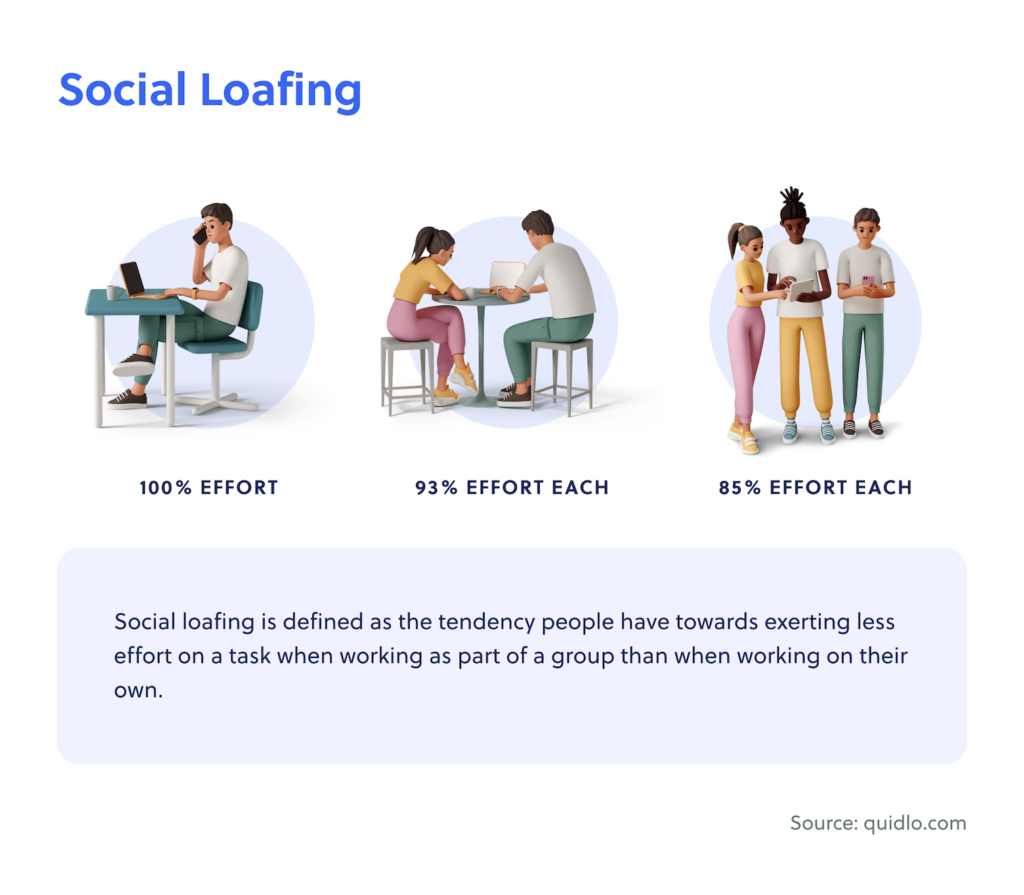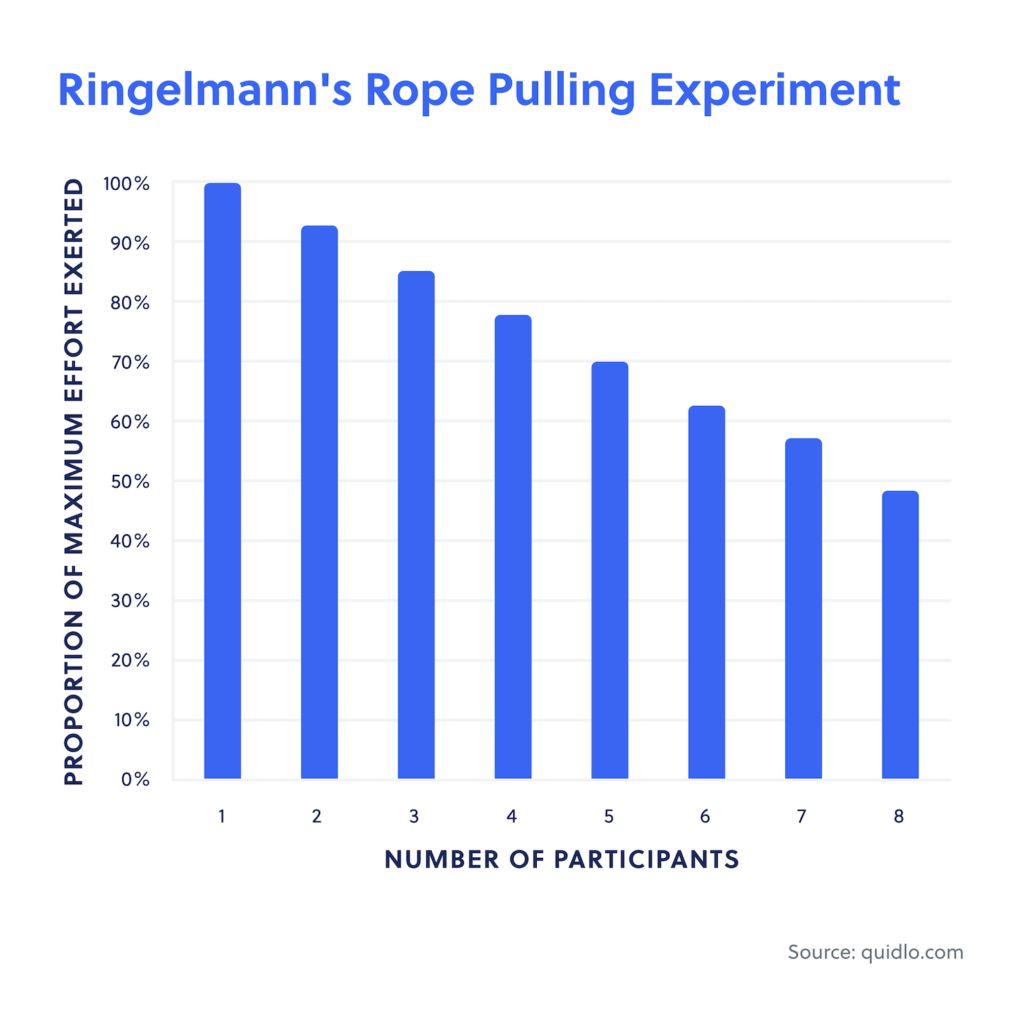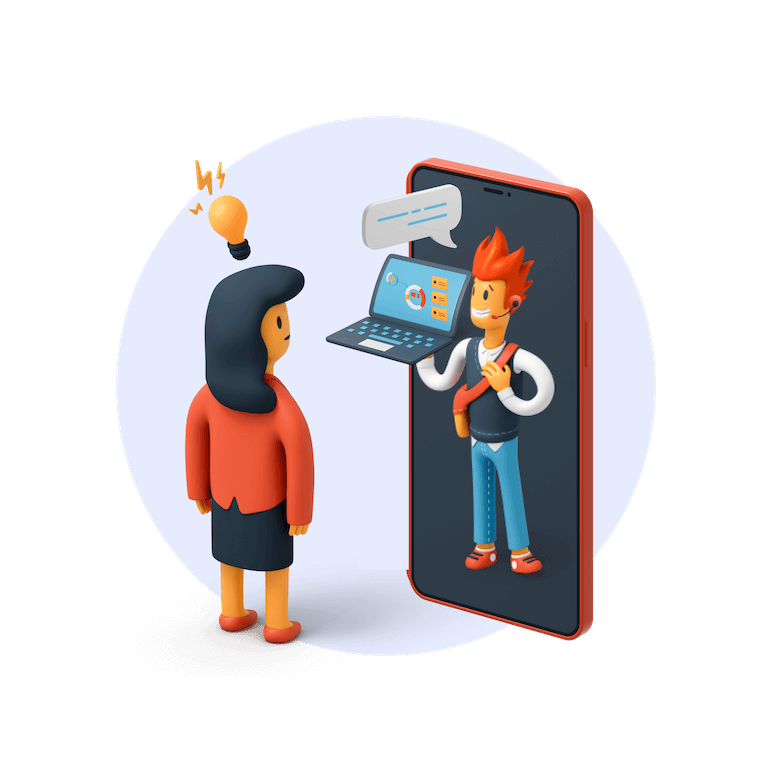Have you ever been part of a group project but got stuck doing all the work while others coast and never pull their weight? Or, have you been part of a team but felt that you wouldn’t make much difference with your contribution, so sat back and let your teammates take over?
If you’ve ever been in this very common situation before, you may question the effectiveness of teams. The ancient Greek philosopher Aristotle once said that “the whole is greater than the sum of its parts” – meaning that a collective team would have greater output than each individual would alone. Despite this, if you’ve been the one taking on the pressure and workload while other team members sit back, you’ll know how de-motivating it can be.
The phenomenon being described here is called social loafing and refers to what happens to the effort levels of people when they’re part of a team. In this article, we’ll explore the concept in detail, exploring the meaning, causes, and how you can prevent social loafing in your next team project.

Table of Contents
What is social loafing?
Social loafing in psychology is defined as the tendency people have towards exerting less effort on a task when working as part of a group than when working on their own. The concept was first identified in the 1913 by French agricultural engineer, Maximilian Ringelmann. In a series of tug-of-war studies, Ringelmann found that as more people were added to the group, each individual’s level of effort decreased. This is called the Ringelmann effect and refers to the correlation between group size increasing, and individual effort decreasing.
Since Ringelmann’s original research, modern studies, including an experiment that involved people clapping and shouting in different-sized groups, have also revealed clear evidence of social loafing and its effects on group output success.

In simple terms, social loafing is when someone is doing less work in a group than they would on their own. It’s what many students, employees, and sports players experience on a regular basis, and can have many detrimental effects on the team dynamic and motivation levels.
When does social loafing occur?
People tend to loaf socially for a number of different reasons. Social loafers are also usually unaware that they are even doing so at all. Social loading occurs when an individual has one or both of these two core beliefs:
- They do not have individual responsibility
In a group setting, people often lose their sense of individual responsibility. They don’t feel the pressure of being responsible for the performance of the team and are consequently not concerned about the blame being placed on them if things are unsuccessful.
- They don’t believe they will achieve much
Social loafing also occurs when an individual has reduced belief in the value of their contributions. They don’t think their role in the team will make much difference to the overall output. They may feel this way by comparing themselves negatively to others, assuming that other team members are better, smarter, or stronger than them.
The conclusion social loafers come to from both of these beliefs is that their participation in the team is optional. They exhibit what is known in psychology as the ‘free-rider effect’ – the concept of taking a step back and letting others compensate for their inactivity.
Group level factors that result in social loafing
Key group factors that contribute to social loafing include anonymity, unclear or overly easy goals, and unidentifiable individual contributions.
Anonymity
Social loafing is more likely to occur in bigger groups, as Ringelmann found when he increased the size of the groups in his rope-pulling experiments. Large groups heighten personal tendencies towards social loafing because they increase anonymity. The more people in a group, the less easy it is to identify and place responsibility on individuals. If everything goes wrong, for example, the blame won’t be placed on them.
Unclear or overly easy goals
Social loafing occurs when there is a general collective team goal but no specific individual goals for each team member. If each individual is unclear about what they need to achieve to contribute to the bigger picture, they won’t feel like a valued member of the team.
Additionally, social loafing occurs when the group goals are too easy. When people are not challenged, they are more likely to feel demotivated and as a result, will slack off or put in minimal effort.
Unidentifiable individual contributions
Similarly, when people cannot see the demonstrable impact of their actions, they will tend to think that they are simply not worth doing at all. Social loafing is likely to happen when team members aren’t clear on how their contributions are important to the bigger picture.
What are the effects of social loafing?
Social loafing is an incredibly common phenomenon, but that doesn’t mean that it is not something to be concerned about. Social loafing can have detrimental effects in different contexts, on both the social loafer themselves, and on other team members.
The effect of social loafing on the individual
Social loafing greatly reduces the loafer’s productivity levels. If they don’t feel their contributions are needed to keep the group on track, they won’t be motivated to work efficiently. Their unproductivity can also go unnoticed in the group setting – especially if others are covering all the work of the loafer, which may encourage them to continue doing this for long periods of time.
Continuous social loafing in this way will also negatively affect the development of the individual. They won’t be challenged and so won’t gain any new skills in the process.
The effect of social loafing on others
Social loafing not only affects the person doing it, but it also impacts the whole group they are part of.
If even just one member of the team is not working at their full potential, the group performance can suffer. When the social loafers in the group fail to put in the effort, it will be harder for the collective to meet their goals.
This can then lead to the ‘sucker effect’. The sucker effect refers to the feeling other group members get when they noticed a free-rider or social loafer. If they spot that someone is failing to pull their weight, they can feel duped – like a ‘sucker’. Why should they have to put in all the effort when others aren’t? This results in them taking a backseat too, and joining the social loafer in disengaging themselves from the work at hand.
Social loafing can also severely affect group cohesion and ‘team spirit.’ People who aren’t contributing to the team will create a negative atmosphere and will cause others to feel demotivated and unhappy about the group dynamic. Team members won’t work well together if everything is set out unfairly.
The effect of social loafing on a business is also very negative. Social loafing means wasted resources and costs. Any employee who is not working to their full potential costs the organization money in the long run.
Is social loafing unethical?
Social loafing can be considered to be unethical depending on the context. It can be argued that social loafing is unethical when the individual makes the conscious decision to avoid or neglect their responsibilities within the team, specifically for a self-serving reason such as laziness. In this case, the social loafer is benefiting of the hard work of others in the team, while not exerting the same level of effort, which is both unfair and unethical.
In addition, this example of social loafing is also unethical as it can negatively impact the performance and opinions of other team members. The social loafer’s poor effort may mean that the group is unable to deliver good quality work, which may impact how managers view all members – not just the loafer.
On the other hand, in certain circumstances, social loafing may not be considered unethical. In psychology, social loafing is proven to sometimes be a subconscious behavior. For example, an individual who is insecure about their own abilities in comparison to other team members may start social loafing subconsciously as a result.
Sometimes, social loafing occurs because of poor team management and goal setting. If people in the team are unclear about the individual role they need to be fulfilling and why it is important for the project, they may unintentionally socially loaf as they lack proper direction and guidance. In this case, the social loafing itself isn’t unethical, more the consequences of poor management.
How to prevent social loafing?
Preventing social loafing is achievable by following the framework listed below. The idea is to structure your group in a way that is beneficial to all team members, holds them accountable, and makes their contributions feel visible.
Ensure collaboration
When setting up your group, make sure that each team member has their own set task to work on. Every single person should have something relevant to do and be held accountable for. The accountability will help motivate each individual to complete their task, and they’ll have a clear direction so won’t be tempted to socially loaf. Properly tracking each team member’s work efficiency is a great way to ensure better collaboration.
Assign content to the right people
In everything, people all have their own unique strengths and weaknesses. Work with your team to decide who is best to complete each task. Assigning tasks to suit personal attributes is a great motivation technique by letting people do what they do best. When people are good at something, they’re much more likely to get stuck into it than if they struggle with it.
Give team members choice
Teams work much more effectively when each member is driven to do what they want to do, and how they want to do it, rather than one person at the top dictating everything. Giving team members a choice of what their tasks should be will assign them ownership and will make them feel personally responsible and connected to their work.
Make the task feel important
Make sure each team member believes that the importance of the task is high. People are far more likely to put in the greater effort if they view the project as important. Zacarro (1984) discovered that groups worked a lot harder if they thought the relevance of the task was high and that the task itself was attractive.
Limit group size
In psychological research by Simms & Nichols, the larger the group – the greater than chance social loafing will happen. To prevent this, keep group sizes small. This will give each team member more accountability and they will be unable to hide in anonymity.
Make goals challenging but clear
Find the balance between challenging goals that motivate each team member, and goals that are clearly structured and easy to understand.
How to reduce social loafing?
Even with the outlined prevention measures in place, social loafing can still definitely occur in group projects. The best way to address social loafing is to establish good communication with all members of the team and regularly check in with them to spot problems early on. Listen to what they have to say and review how motivated they feel towards their work. Find out if they believe any other team members aren’t putting in enough effort; if they are clear enough on their individual tasks and goals; and if they believe they are putting in their full effort.
In these regular reviews, make sure to also evaluate individual performance as well as that of the whole group. This will encourage accountability and will ensure that no one is able to hide low effort. Highlighting the achievements of individuals is equally important, as it will keep up the motivation of individuals and help everyone to feel recognized for their contributions.
Examples of social loafing
Social loafing can occur in all kinds of settings and contexts, from school to sports. Here are some of the most common social loafing examples in different environments.
Examples of social loafing in psychology
Social loafing in psychology is usually explained using Ringelmann’s tug-of-war example. He asked a group of men to pull on a rope alone and then together as part of a group. The results showed that the men did not pull as hard collectively as they did when on their one, leading to Ringelmann’s conclusion that group settings can lead to social loafing.

Another example often used in psychology is an entertainer on stage asking the audience to clap or cheer. In a large crowd, often when the person on stage asks the audience to do something, they don’t respond will their full effort. That’s why you’ll often hear the performer say something like “that wasn’t loud enough!”
Examples of social loafing in business
Social loafing is also common in business settings. It can happen in a variety of settings, but one of the most common is in meetings. An example is people not contributing or speaking up in an extensive group brainstorming session as they either don’t want to contribute or don’t value their efforts.
Another example is a team working together to achieve the collective goal of making $1M but not calculating who is responsible for bringing in what revenue and how. This would encourage social loafing as the pressure of achieving this goal and the accountability for it, is not broken down and assigned to individuals.
Examples of social loafing in the workplace
Social loafing is also common in the workplace itself. An example of social loafing in an office setting would be the team’s failure to clean up communal spaces. As the responsibility is not broken down into individual tasks, social loafing could occur and people would take advantage of the fact that the blame could not be solely assigned to them as individuals.
Remote teams can also fall victim to social loafing, particularly with online video calls. With virtual meetings, it is even easier for team members to mute themselves, take a backseat and let others speak up or take on work tasks.
Remote work can also make accountability more difficult to assign. When employees are not in the same physical space as their managers, they may lack motivation and be inclined to socially loaf more on projects. This can be especially difficult when employees work across different time zones. Digital tools, including time tracking apps, can help increase accountability in remote work.
Examples of social loafing in sport
Social loafing is also very common in team sports. One example is rowing. In rowing, the team must row together to move the boat along quickly. In group rowing, a person may put in less effort and social loaf because they believer their effort is helping much overall or because they know they won’t be blamed as an individual.
Another example is football. Sometimes players will fail to make a move because they assume another player will do it instead.
Sports team coaches achieve incredible results when they motivate the collective team and the individuals as well. When athletes feel visible and valued, they perform better together.
The scale of social loafing
Social loafing is a huge global problem for businesses across all industries. Greater awareness of the prevalence of social loafing is one of the best ways to tackle it. The more people and businesses that are aware of what causes social loafing and how to prevent it, the easier it will be to tackle the issue.
Here are some of the most important statistics to know about:
- 71% of executives say that employee engagement is critical to their company’s success.
- This is because, compared to social loafers, engaged employees are 18% more productive and 23% more profitable. (Gallup.com)
- As well as this, engaged employees increase productivity by 17%, Increase customer ratings by 10% and increase sales by 20%. (Gallup.com)
- Unlike social loafing, employee engagement and motivation also reduces absenteeism by 41%. (Gallup.com)
- Yet, only 15% of employees are engaged in the workplace! That’s 85% who are social loafing. (Gallup.com)
- It’s a hugely expensive problem. Employee social loafing costs businesses on average $450-550 billion each year. (conference-board.org)
Final words
In summary, social loafing is a phenomenon that occurs in group settings. It refers to a person putting in less effort than they would do alone. It was identified by Maximillian Ringelmann who found that people playing tug of war would work less hard as a group than individually. Examples of social loafing can be found everywhere: in sports environments, at work and school, and even with performers in front of crowds.
As we have covered, social loafing occurs for a number of reasons including personal thought-processes like the individual believing their contributions won’t make a difference; and group-level factors such as anonymity, unclear goals or large group sizes.
Social loafing can have a variety of detrimental effects on the group – causing people to collectively feel demotivated by the social loafer and making the group performance suffer. This is what can make some forms of social loafing unethical, as one person’s actions can negatively affect other members of the group.
Luckily, social loafing can be tackled through better team management and planning. Some of the ways this can be done in practice are by making sure each individual is accountable for their set tasks by assigning them based on personal attributes and giving team members a choice.
Social loafing is a key problem and something that businesses should not overlook. It can be both costly and a drain on company resources, and can seriously affect profitability. Using the methods we’ve outlined, why not see if you can spot and tackle social loafing in your organization today?







